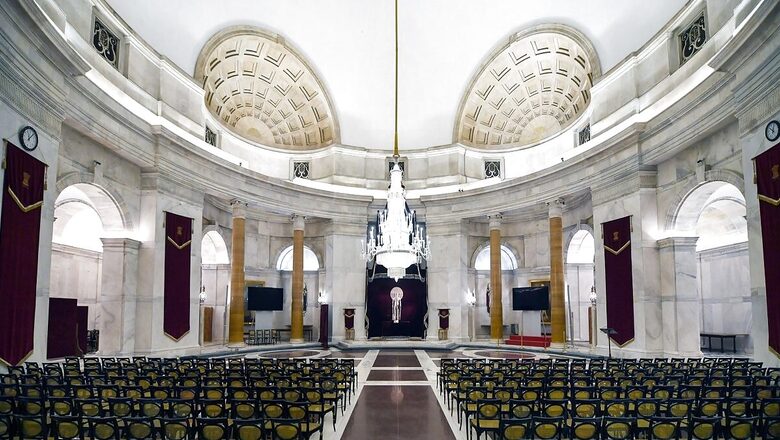
views
The lucky few who have had the privilege of being shown into the Durbar Hall of the Rashtrapati Bhavan would have been struck by its courtliness. The mammoth Belgian chandelier that dangles over the ‘head of the republic’ from the domed hall illuminates a day punctuated by rigid protocol. Essentially, fripperies fit for a regent. Their weight almost immediately constricts the attendee into observing procedure, almost always designed to make the “Excellency” look more excellent.
Beyond the protocol, there is the Durbar Hall’s statuary to contend with. And, no, we aren’t referring to the priceless artworks but to the real-life guard that flanks the Rashtrapati. The imperious “presidential bodyguard” ensures that the invitees keep their required distance. Proximity, after all, could rob the “eminence grise” of alluring quintessence.
Indeed, the British may have exited the scene, but the stiff upper lip still defines the visage of the liveried sentinels of the Rashtrapati Bhavan. No, not a trace of emotion betrays the icy deportment of this bit of imperial regalia.
Once the eye has furtively surveyed the scene, it settles upon the President, sitting on a throne atop an altar framed by an apse, looking benignly onto the assembled ‘Durbar’. In this crusty and frosty Durbar Hall, all the talk of the Rashtrapati Bhavan being the “symbol of the nation” that is “accessible to the people” rings hollow.
So, one was glad to hear that President Droupadi Murmu has struck the first blow against “durbarism”. A press release from her office informed us that Her Excellency was “pleased to rename two of the important halls of Rashtrapati Bhavan – namely, Durbar Hall and Ashok Hall – as Ganatantra Mandap and Ashok Mandap, respectively”.

The communique also noted the reasons for the decision. It explained that the “term ‘Durbar’ referred to courts and assemblies of Indian rulers and the British. It lost relevance after India became a Republic, that is, ‘Ganatantra’. The concept of ‘Ganatantra’ is deeply rooted in Indian society since ancient times, making ‘Ganatantra Mandap’ an apt name for the venue”. For added emphasis on republicanism, the ‘Ashok Hall’ that was originally a ballroom has also been renamed. The Rashtrapati Bhawan has pronounced that the word ‘Ashok’, among other things, “refers to the Ashok tree which has deep significance in Indian religious traditions as well as arts and culture. Renaming ‘Ashok Hall’ as ‘Ashok Mandap’ brings uniformity in language and removes the traces of anglicisation while upholding the key values associated with the word ‘Ashok’.”
But to ensure that “nameplate nationalism” is truly imbued with meaning, change must go beyond the superficial.
There’s a need to redefine the Presidency itself. A welcome beginning has been the move towards ensuring greater representation in the highest Constitutional office. President Murmu, a tribal from modest means, has seen her stature grow in office, giving hope that India’s democracy embodies diversity. However, more could be done. Perhaps the time has come to reserve a percentage of presidential appointments for marginalised communities. Additionally, the President’s council could be made to mandatorily reflect India’s diversity.
But if governance is to be truly inclusive, transparent, and subject to meaningful checks and balances, the President’s office needs to shed the impression of being merely a sinecure. Terms like “rubber stamp”, “glorified political appointee”, and “cheerleader” are increasingly used to describe presidents. This perception can be reversed by granting the President more discretionary powers, particularly in addressing national crises and emergencies. The President could also be given the authority to take proactive measures on critical issues such as corruption, the economy, and national security.
To guard against overreach, or what is often described as the “tyranny of the unelected,” the President’s office could also be subject to increased accountability. One possible step could be to introduce impeachment procedures for the President. Another measure could involve establishing an independent advisory body to monitor the President’s performance.
Some may flinch at the breadth of these suggestions. And, this article doesn’t purport to know all the answers, but there is no gainsaying that the President’s office today needs to not just be seen as more effectively relevant, but be so. A debate is needed that goes beyond quibbling over nomenclature. And such an inquiry would be a more fitting tribute to the legacy of the legendary “Ashoka” of yore, surely.
Views expressed in the above piece are personal and solely those of the author. They do not necessarily reflect News18’s views.
















Comments
0 comment